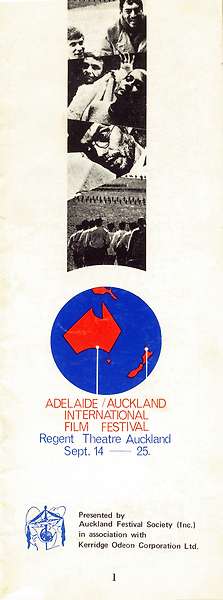
Occasions move different people in different ways. Take for example, the Adelaide-Auckland International Film Festival. At the end of the Hungarian-Soviet movie The Red and the White (a tableau of revolution in 1917), one member of the South Australian audience was seen to leap to his feet to declare: “You have just seen why we will not fight! We will never be conscripted!” Locally, the vision of a portly middle-aged screen character stripped in to a body-clinging, striped woollen swimsuit of the 1920’s in Capricious Summer, evoked a breathless “Fabulous gear!” from the darkness of the stalls.
They say that annually round the globe there are some 300 film festivals. This was New Zealand’s first venture of the kind. It began as something of a gamble. Unlike Adelaide, Auckland has not the diverse racial groupings calculated to send audiences scurrying to productions from Central Europe, the Far East or the rim of the Arctic Circle. Some Italians, yes. A handful of French, maybe. A number of itinerant Japanese. But where to find more than the occasional Argentinian, let alone a Bulgarian to match the several thousands in Adelaide? Would the student population and the film buffs turn out in numbers large enough to take the slack?
With Australian know-how born of 10 years at the game allied to Kiwi enthusiasm, planning began in mid-1968. To producers the world over went invitations to compete. And the entries began to flow in: from Pakistan and Poland, Rumania and Rhodesia, Israel and the Philippines, Mexico and Hong Kong. The films followed. An Indian entry, by way of a festival in Berlin, a Russian one from Vancouver. In Canberra, a Japanese film got itself banned by the Censor; the process was repeated in Wellington a week later. A Polish offering – heavy with honours – failed ever to arrive, grounded, perhaps, in Rio de Janeiro or waylaid in Warsaw. Despatched from Sydney, an Italian production shot through Mangere before being off-loaded in Los Angeles.
For 12 days at a Queen Street cinema there were beards, bare feet and jeans (and jalopies at the kerbside) for the Auckland section of the two cities’ festival. On the first night black ties and cocktail dresses seemed somehow incongruous. The official opening by an MP flanked by a group in national costume (the film de jour was the Scandinavian Hunger), assumed briefly the air of an election meeting when a claim was made that the occasion marked a “great leap forward” for New Zealand. Clearly the audience had come for pictures not pleasantries. That brief interlude apart, Auckland provided but one personality. The noted Indian director, Satyajit Ray had been expected to accompany his newest film, The Adventures of Goopy and Bagha, but was detained in Calcutta. His producer came instead, but leaving his homeland a little late, missed his flight connection in Sydney and arrived the day after his production had screened.
In the space of 12 days, 14 features and 23 short films were shown, the output of some 18 countries. There were works of “Big-name” craftsmen like Robert Bresson (Au Hasard Balthazar) and Ray; of younger, but already entrenched ones like Noburu Nakamura (Springtime), Miklos Jancso (The Red and the White) and Jiri Menzel (Capricious Summer); and debuts, or near-debuts of tyros like Jack Gold (The Bofors Gun), Menahem Golan (My Love in Jerusalem), Jan Nemec (Report on the Party and the Guests) and Walerian Borowczyk (Goto, Isle of Love). There were oddities, too. Diverting ones like Ermanno Olmi’s near documentary. The Engagement; exotic ones like Mircea Dragan’s The Column. Boys’ Own Paper stuff from Rumania but with artistry enough to set it apart from the conventional Hollywood epic; weird, way out ones like Canadian David Cronenberg’s Stereo. Along with the feature films, came a galaxy of short ones, many of them distinguished in their diverse fields and, like the National Film Unit’s stylish soft sell for tourism, Wild September Snow, deserving of the applause they got. Dove-tailed into the 12 different programmes they added lustre to the festival and gave Aucklanders as exciting a season of picture-going as they have ever had.
Suddenly it is over. Festival-goers with ears attuned temporarily to French and Hebrew, Bengali and Danish, readjust to the native tongue. The eye-exercise of “down, up, down, up”, action to sub-titles, is finished. Auckland is far from making the Berlin-Cannes-Moscow league. Given time, though, it could join places like Cork, Karlovy Vary and San Francisco as a non-competitive showcase for the 20th century’s most exciting art form. In this city of 600,000, there are young people intelligent, interested and informed enough to make the venture well worthwhile. 16,000 paid admissions prove it. — Wynne Colgan, New Zealand Listener, October 27, 1969
Image: First Adelaide-Auckland International Film Festival booklet cover, 1995